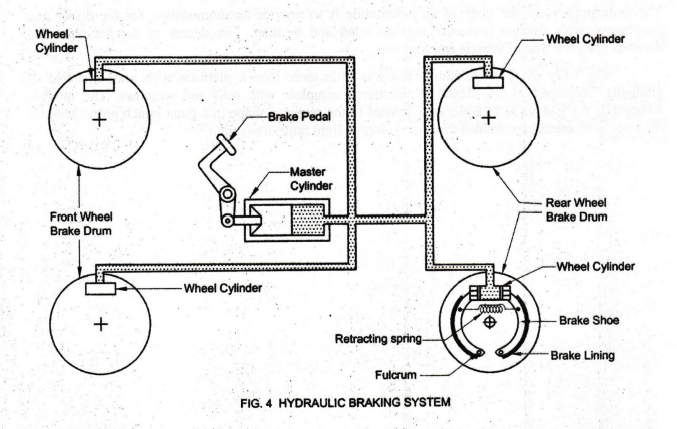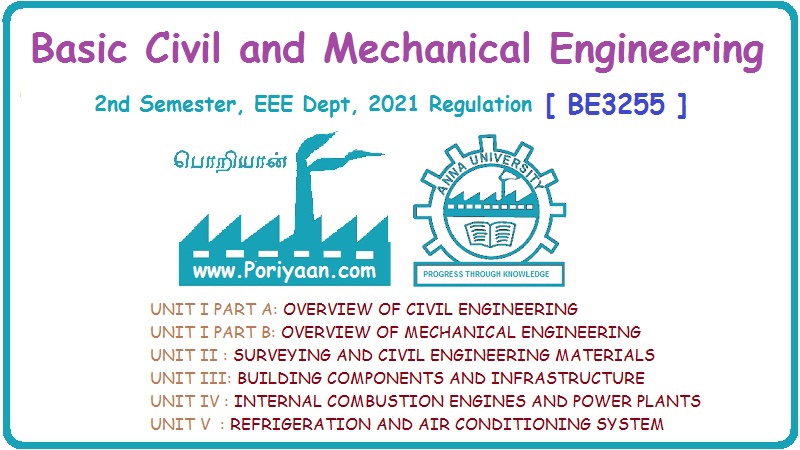Basic Civil & Mechanical Engineering: UNIT I: m. Automobile engineering
Functions of the automobile components
1. Engine, 2. Lubrication System, 3. Cooling system, 5. Ignition system 6. Electrical system 7. Chassis 8. Suspension system 9. Power train 10. Clutch 11. Drive shaft 12. Differential 13. Axle 14. Wheels 15. Steering system 16. Braking system
FUNCTIONS OF THE AUTOMOBILE COMPONENTS
1.
Engine
The
engine consists of a cylinder, piston, valves, valve operating mechanism, fuel
injector, radiator fan, fuel feed pump, oil pump, etc. The engine components
are explained in Chapter 17.
The
explosive power of the air-fuel mixture drives the piston. The piston turns a
crankshaft to which it is connected. Thus, the linear motion of the piston is
converted into rotary motion of the crankshaft, resulting in the rotary motion
of the wheels of an automobile.
A
number of systems are necessary to make an engine work. A lubrication system is
needed to reduce friction and prevent engine wear. A cooling system is required
to keep the engine's temperature within safe limits. The engine must be
provided with a proper amount of air and fuel by a fuel system.
The
air-fuel mixture must be ignited inside the cylinder at just the right time by
an ignition system. An electrical system is required to operate the cranking
motor that starts the engine and also provide electrical energy to operate
engine accessories.
2.
Lubrication System
An
engine has many moving metallic parts. The relative motion between the moving
parts leads to friction, heat generation, wear and loss of power in engine. Oil
is circulated between the moving parts to prevent metal-to-metal contact which
leads to wear.
.
The primary function of a lubricant is to reduce friction and power loss. The
secondary function of a lubricant is to act as a coolant and also as a sealing
medium to prevent leakages. The commonly used lubricating systems are splash
system and forced feed system. The major parts which require lubrication are
cylinder walls, piston, cooling fan, ignition mechanism and bearings of
crankshaft and connecting rod.
3.
Cooling system
The
fuel is burnt inside the cylinder of an internal combustion engine to produce
power. The temperature attained can be as high as 1600° C and this is greater
than the melting point of engine parts. This increase of temperature directly
affects the engine performance and the life of the engine parts.
The
cooling system keeps the engine operating at an optimum temperature for
efficient operation under all conditions. Whatever the driving conditions may
be, the system is designed to prevent both overheating and overcooling.
The
cooling system helps to dissipate surplus heat for protection of engine
components like cylinder, cylinder head, piston, piston rings, and valves and
also aids in maintaining the lubricating property of oil inside the engine. The
systems adopted for cooling are (i) Air cooled system and (ii) Water cooled
system.
Air
cooled system: The system in which heat is directly
dissipated into the air around the cylinder wall is called air cooled system.
In order to increase the heat transfer rate, metallic fins are provided on the
outer surface of the cylinder as shown in Fig. 2. This type of cooling is used
for smaller capacity engines used in scooters and motor cycles.

Water
cooled system: Water is used as a cooling medium. It
is circulated through special cooling passages present in the engine. It is
used for medium and large capacity engines, viz., cars, buses, trucks, etc.
4.
Fuel system
The
main function of a fuel supply system is to provide fuel to the injection
system. The rate and pressure with which the fuel is supplied should be
sufficient to meet engine demands under all conditions of load, speed and
gradients encountered by the vehicle. The fuel system must also have enough
reserve fuel for several miles of vehicle operation.
5.
Ignition system
The
fuel supplied to the combustion chamber must be ignited to deliver power. The
purpose of the ignition system is to provide assistance for the combustion of
fuel. The assistance is provided either by a high voltage spark or
self-ignition in each of the engine's cylinders at the right time so that the
airfuel mixture can burn completely.
In
a spark-ignition engine, an electric spark is used for ignition purpose. The
compressionignition engine does not require a separate ignition system because
the ignition takes place by compression of the air-fuel mixture to a higher
pressure.
6.
Electrical system
The
engine's electrical system provides energy to operate a starter motor and power
all the accessories. Its main components are battery, alternator, starter
motor, ignition coil and heater.
7.
Chassis
A
chassis is a skeletal frame on which various mechanical parts like engine,
tires, axle assemblies, brakes, steering etc. are bolted. The frame provides a
foundation for the engine and body of the vehicle. It is constructed from
square or hollow cylindrical steel members strong enough to support the weight
of the body and other components. They are welded or bolted together to give
the final shape.
The
engine is mounted on the frame with rubber pads to absorb and dampen vibrations.
The frame is supported on wheel axles by means of springs. The frame shown in
Fig. 1 consists of two long members and four cross members.
8.
Suspension system
The
function of the suspension system is to absorb vibrations due to the up and
down motion of wheels caused by the irregularities in the road surface. The
springs, connecting linkages, and shock absorber comprise the suspension system
of a vehicle.
The
suspension system is broadly classified into two types:
Rigid
system: The springs are attached to a rigid beam axle. It
is mostly used in the front axle of commercial vehicles and in the rear axle of
all types of vehicles.
Independent
system: It does not have a rigid axle. Each wheel is free to
move vertically without any reaction on its mating wheel. It is mostly used in
small cars to provide more comfort.
9.
Power train
The
power train consists of components that generate power and deliver it to the
wheels of an automobile. This includes the engine, transmission, drive shafts,
differential and the final drive to drive wheels.
10.
Clutch
The
purpose of clutch is to temporarily disconnect the engine from wheels. When
clutch is in the engaged position, the engine power flows to the transmission
through it. When gears are to be changed while the vehicle is running, the
clutch permits temporary decoupling of engine and wheels so that gears can be
shifted. Such disengagement of the power train from the engine is essential
while changing the gear or stopping the vehicle.
11.
Drive shaft
The
drive shaft or propeller shaft connects the gearbox and the differential unit.
The drive shaft has universal joints at its ends.
12.
Differential
A
differential is a mechanical element made up of several gears. It transmits
power from the driveshaft to the drive wheels. The main function of
differential is to allow the drive wheels to turn at different speeds allowing
the wheels to go around corners.
13.
Axle
The
axle is a shaft on which a pair of wheels is mounted. The wheels are provided
with the required drive through these axles.
A
portion of the weight of vehicle is transmitted to the wheels through an axle.
The front axle performs several functions. It carries the weight of the front
of the vehicle and also takes horizontal and vertical loads when vehicle moves
on bumpy roads. When brakes are applied on front wheels, it endures bending and
torsional stresses. It is generally made by drop forging of steel to achieve
higher strength. It is robust in construction.
14.
Wheels
The
wheels of an automobile take the load of the vehicle and also produce tractive
force to move the vehicle. The wheels are also used for retardation and
stopping the vehicle.
15.
Steering system
The
steering system is used for changing angular motion of the front wheel so that
the vehicle can negotiate a turn. It also provides directional stability to the
vehicle when the vehicle moves ahead in straight line. The major requirement of
any steering mechanism is that it should be precise and easy to handle.
Moreover, the front wheels should have a tendency to return to the
straight-ahead position after a turn.

The
most conventional steering arrangement is to turn the front wheels using a
hand-operated steering wheel which is positioned in front of the driver, via
the steering column. The schematic diagram of the steering system is shown in
Fig. 3. The track rod and link rod connect the steering arms to the steering
wheels through a steering box.
A
gear mechanism in the steering gear box is used to increase the steering effort
provided by the driver. Vehicle steering is not only required on a curved road
but also while maneuvering on busy traffic roads.
16.
Braking system
The
brakes are required for slowing down or stopping a moving vehicle by reducing
its kinetic energy. The braking system is essential for the safety of
passengers, and passers-by on roads. It may be operated mechanically or
hydraulically. Most of the braking systems in use today are of the hydraulic
type.
All
brakes consist of two members, one rotating and the other stationary. There are
various means by which the two members can be brought in contact, thus reducing
the speed of the vehicle.
The
major components of the braking system are: brake pedal, master cylinder, wheel
cylinders, brake drum, brake pipe, brake shoes and linkages. The components
present in a hydraulic braking system are illustrated in Fig. 4.

As
the vehicle loads and speeds have increased over years, there is a necessity
for improving the braking performance. In order to meet such requirement, power
brakes are now being preferred. Power brakes are a system of hydraulics which
utilize vacuum and air pressure to provide most of the braking effort.
Hand
brake or parking brake is mechanically operated. The mechanism consists of a
handoperated lever and a locking mechanism that will keep it engaged until
manually released. It is used for parking the vehicles on sloppy surfaces and
also in case of emergency.
Basic Civil & Mechanical Engineering: UNIT I: m. Automobile engineering : Tag: : - Functions of the automobile components
Related Topics
Related Subjects
Basic Civil and Mechanical Engineering
BE3255 2nd Semester 2021 Regulation | 2nd Semester EEE Dept 2021 Regulation
